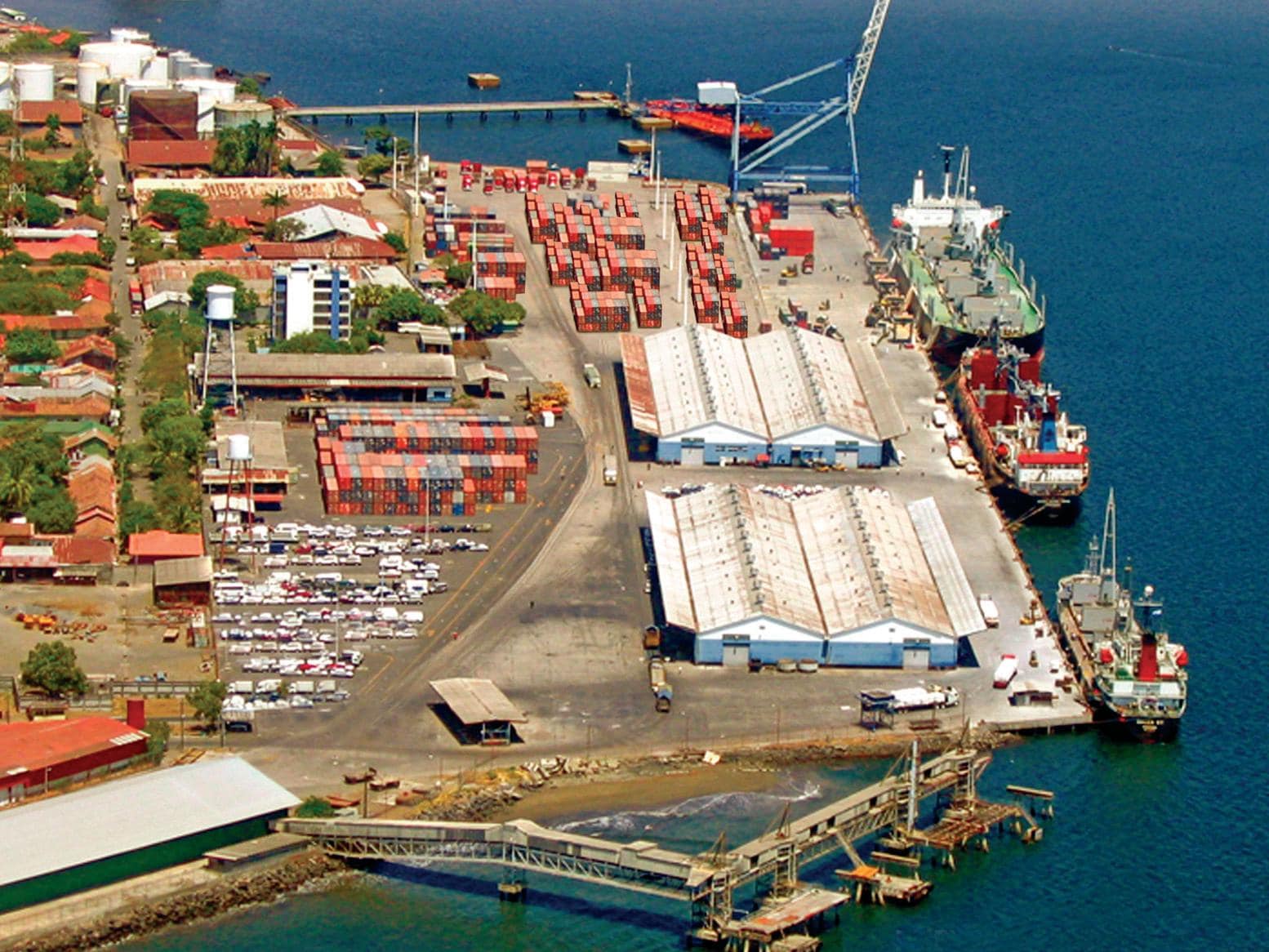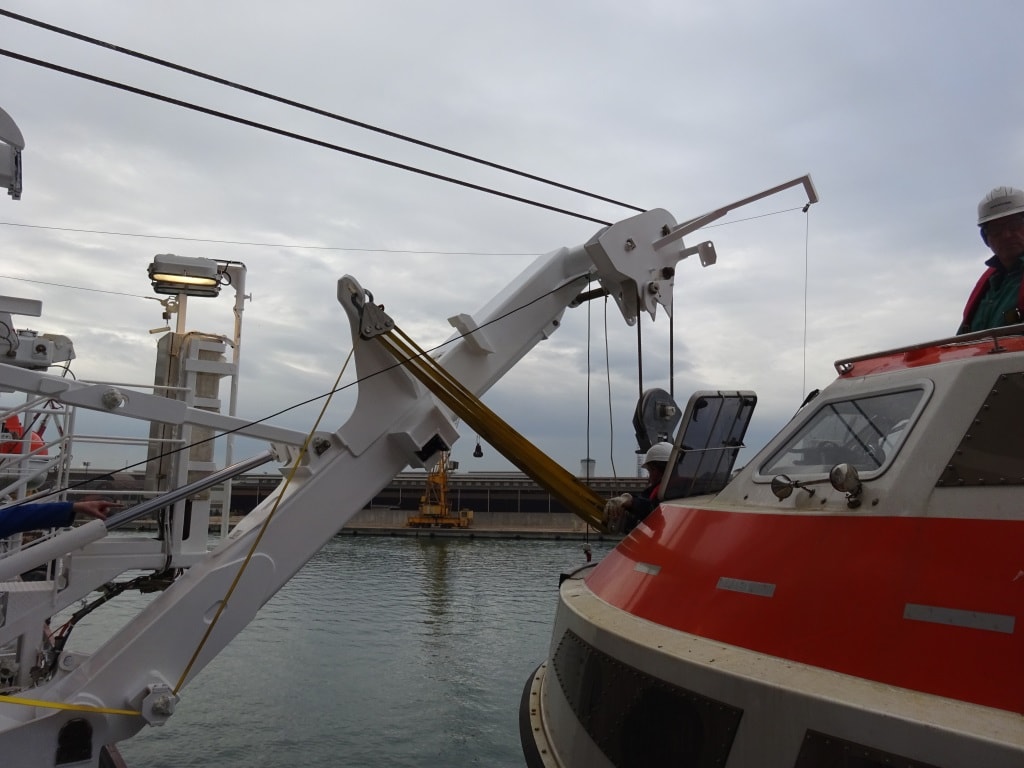Our guests have been indicating that they enjoy Corinto and thus Holland America is now having more ships calling here during Trans Canal cruises and re positioning cruises to and from Alaska. My first time here was in 1979 when I was cadet on a container ship just after the revolution and things where rather hairy. I was there with a container ship which sailed for a company that was once the cargo part of Holland America until it was split off on 1 January 1973. The management of the remaining passenger ship part of Holland America wanted to concentrate on cruising. These were most interesting calls as the ship was very advanced for that time and the local longshoremen could not handle the equipment (Or those who could had run away during the political changer over, I never found that out) and thus it fell upon us, cadets, to run either the ships cranes or the large shore crane which had been installed a few years before.

The Dock at Corinto. This is an air photo of the port from 2 years ago and also then the crane was already out of order. Currently they are tearing down the two sheds on the dock.
Routine was then that the Engineers would check over all the shore equipment including the large fork lifts before the deck officers would and could get the show on the road. And so there was little me, sitting there in the crane, with a sleeping longshoreman beside me who was supposed to do the job but could not, and at times a gun toting Sandinista behind me, ensuring that the whole unloading procedure was carried out in a sufficiently revolutionary way. The crane is still there, albeit a long time out of order; but every time I see it I have to remember my activities as a budding crane driver. During subsequent calls we used our ships cranes as that worked a bit faster as long there were sufficient trucks to drive the goods away.
Sailing into Corinto can be unpleasant due to the swell running across the entrance channel and yes we rolled a bit but it was not too bad. I was having breakfast in the Lido and being incognito it is fun to listen to all the experts around me, explaining and complaining about why we were “tipping sideways”. As usual very few people had listened to the Captains announcement about this, so the most wonderful theories and nautical expressions (mostly out of context) were bandied around. Now I have learned that when a ship goes into port, it does not roll; it can only list because the stabilizers are not out; moreover it can list to both sides at the same time. Who says that breakfast in the Lido cannot be educational?

This is the forward tricing pendant from a tender on the Koningsdam with a rigger in action. It holds the lifeboat to the ship to make embarkation possible and then it has to be disconnected before the lifeboat can be lowered.
While on education, I promised yesterday to explain about Closed Loop Communication. I have a whole series of training going on at the moment, to educate the lifeboat crews in using this technique as it reduces misunderstandings. We have it in use on the bridge for a few years now and it works very well as soon as you start using it routinely. Closed Loop Communication is simply a repeat and confirm exchange which eliminates assumptions and half understood orders or announcements. It is great for situations where the sender and receiver are a certain distance away from each other, or cannot see each other. Even more so, when they belong to different nationalities and they have to work together for safety routines. Such as in a lifeboat where the crew member in the bow and in the stern is completely hidden from the view of the commander if there are 150 people sitting in the boat.
It goes like this:
Commander: Release tricing pendant forward (that is a line that keeps the lifeboat bow to the ship)
Boat rigger forward: Releasing tricing pendant?
Commander: Yes
The commander now knows that the boat rigger has understood the message and is ready. The boat rigger (the person in the bow or stern of the lifeboat) knows the commander has understood he/she is ready as the repeat of the command is acknowledged.
Tricing pendant is released. (Something the commander cannot see)
Boat rigger: tricing pendant released
Boat commander: tricing pendant released?
Boat rigger: Yes.
It is very simple and it reduces mistakes. It can and should sometimes be used in civilian life as well. How many people forget to put the trash can out at night and the other half, most of the time the better half, just assumes it has been done………….. because it always gets done. That is an assumption and a form of complacency and a little closed loop would sort that one out.
Tomorrow we are in Punta Arenas Costa Rica. We are there with two NCL ships so it will be busy and it will be as warm and as sunny as it was today.

October 15, 2017 at 12:41 pm
Captain Albert
Loved your explanation of “Closed Loop Communication.” As a missile Officer in the U S Air Force we called it “Demand-Response” and like on the ships it ensured that everyone understood what was being accomplished.
Regards,
Roger T
October 15, 2017 at 4:39 pm
You were in Puerto Corinto and didn’t check on the status of the school project you so admirably started many years ago as Captain of the Statendam??
Or am I simply dating myself as an old F*rt??……Ruud Hartog
October 16, 2017 at 8:59 am
Thank you for still reading my blog.
I did but the head teacher was not in, and the rest did not speak a single word of English.
The paint was still holding and the curtains were still up. On my next Trans Canal I will try to start a fund raiser again when there is more time.
This time the ship was too tied up with all sorts of audits and related.
Best regards
Capt. Albert
October 17, 2017 at 6:31 pm
We called it Three Peat. We were to conclude with “that is correct”